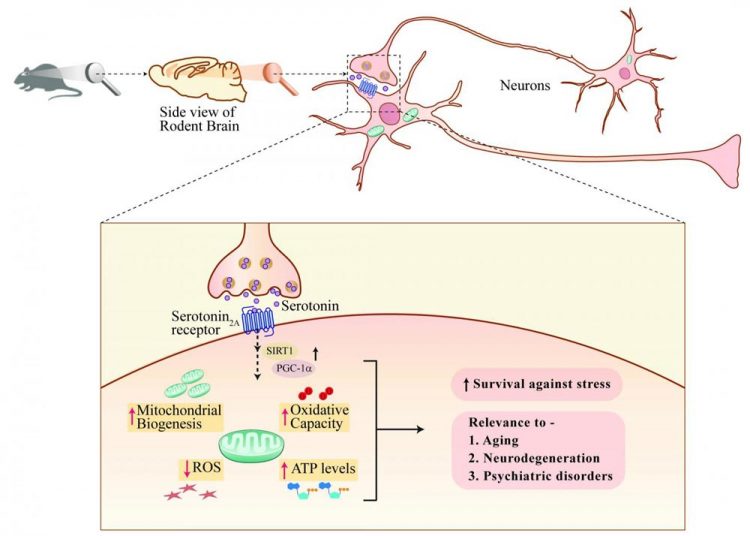Serotonin boosts neuronal powerplants protecting against stress

This is serotonin action on neuronal mitochondria. Credit: Vidita A. Vaidya and Ullas Kolthur-Seetharam
Collaborative research by Prof. Vidita Vaidya and Prof. Ullas Kolthur-Seetharam groups at TIFR, along with Dr. Ashok Vaidya, at Medical Research Centre, Kasturba Health Society, has demonstrated an unusual function for the neurotransmitter serotonin, in the generation of new mitochondria–a process called mitochondrial biogenesis–in neurons, accompanied by increase in cellular respiration and ATP, the energy currency of the cell.
These effects of serotonin involve the serotonin2A receptor and master regulators of mitochondrial biogenesis, SIRT1 and PGC-1α. Serotonin reduces toxic reactive oxygen species in neurons, boosts anti-oxidant enzymes and buffers neurons from the damaging effects of cellular stress.
This study (Fanibunda et al., 2019), appearing in the international journal PNAS, uncovers an unprecedented role for serotonin in energy production in neurons directly impacting how neurons handle stress.
Mitochondrial function in neurons is vital in determining how neurons cope with stress and the trajectory of aging.
This work provides exciting evidence that the neurotransmitter serotonin can directly influence neuronal powerplants, thus impacting the manner in which neurons grapple with stress.
This work identifies novel drug targets for treating mitochondrial dysfunction in neurons, with therapeutic potential for neurodegenerative and psychiatric disorders.
Media Contact
More Information:
http://dx.doi.org/10.1073/pnas.1821332116All latest news from the category: Life Sciences and Chemistry
Articles and reports from the Life Sciences and chemistry area deal with applied and basic research into modern biology, chemistry and human medicine.
Valuable information can be found on a range of life sciences fields including bacteriology, biochemistry, bionics, bioinformatics, biophysics, biotechnology, genetics, geobotany, human biology, marine biology, microbiology, molecular biology, cellular biology, zoology, bioinorganic chemistry, microchemistry and environmental chemistry.
Newest articles

Sea slugs inspire highly stretchable biomedical sensor
USC Viterbi School of Engineering researcher Hangbo Zhao presents findings on highly stretchable and customizable microneedles for application in fields including neuroscience, tissue engineering, and wearable bioelectronics. The revolution in…

Twisting and binding matter waves with photons in a cavity
Precisely measuring the energy states of individual atoms has been a historical challenge for physicists due to atomic recoil. When an atom interacts with a photon, the atom “recoils” in…

Nanotubes, nanoparticles, and antibodies detect tiny amounts of fentanyl
New sensor is six orders of magnitude more sensitive than the next best thing. A research team at Pitt led by Alexander Star, a chemistry professor in the Kenneth P. Dietrich…





















